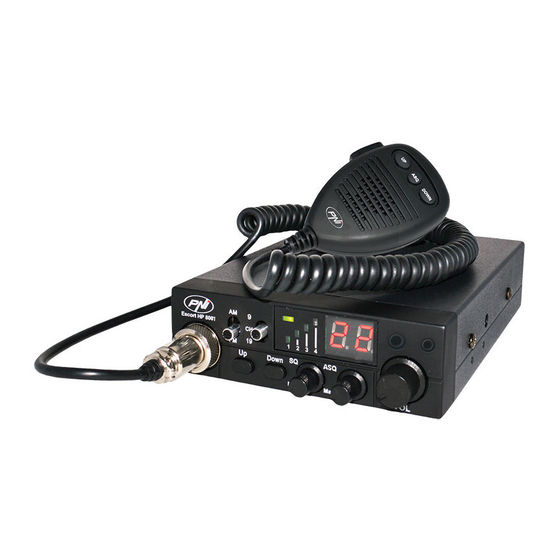
Advertisement
Available languages
Available languages
RO
Adaptor Bluetooth PNI BT-DONGLE 8001
Introducere:
Noul adaptor Bluetooth PNI BT-Dongle 8001 permite conectarea mai multor
dispozitive Bluetooth (casti, smartphone, microfon) cu statia radio CB PNI Escort
HP 8001L dotata cu mufa pentru accesorii audio cu 2 pini tip Kenwood.
Procedura de imperechere BT-DONGLE 8001 cu microfonul BT-MIKE 8500:
1. Cand statia radio este oprita, conectati adaptorul BT-DONGLE 8001. Porniti
statia radio si asteptati ca adaptorul sa intre in modul de imperechere care se
activeaza dupa circa 2 minute, cand ledul incepe sa clipeasca alternativ rosu si
albastru.
2. Porniti microfonul BT-MIKE 8500 si activati modul de imperechere:
• Apasati lung tasta multifunctionala de pe microfon (tasta "M"). Veti auzi
confirmarea vocala"Power on"
• Continuati sa tineti apasata tasta multifunctionala pana auziti mesajul
"Pairing". Ledul va clipi alternativ rosu si albastru pana se va realiza
conexiunea.
• Dupa ce s-a stabilit conexiunea, veti auzi mesajul "Conected". Ledul de pe
microfon va clipi rar albastru.
• Apasati tasta PTT pentru a emite.
Procedura de imperechere BT-DONGLE 8001 cu BT-MIKE 8500 si telefonul
mobil:
Manual de utilizare
1
Advertisement
Table of Contents

Summary of Contents for PNI BT-DONGLE 8001
- Page 1 HP 8001L dotata cu mufa pentru accesorii audio cu 2 pini tip Kenwood. Procedura de imperechere BT-DONGLE 8001 cu microfonul BT-MIKE 8500: 1. Cand statia radio este oprita, conectati adaptorul BT-DONGLE 8001. Porniti statia radio si asteptati ca adaptorul sa intre in modul de imperechere care se activeaza dupa circa 2 minute, cand ledul incepe sa clipeasca alternativ rosu si albastru.
- Page 2 2. Inchideti BT-MIKE 8500. Tineti apasat lung tasta multifunctionala pana auziti mesajul “Power off“. 3. Imperecheati BT-MIKE 8500 cu BT-DONGLE 8001 (urmati pasii descrisi la procedura anterioara) 4. Reconectati manual BT-MIKE 8500 la telefonul mobil Acum toate cele 3 dispozitive: microfon, adaptor Bluetooth si telefon mobil sunt conectate.
- Page 3 3. Imperecheati BT-MIKE 7500 cu BT-DONGLE: • Cand statia radio este oprita, conectati adaptorul BT-DONGLE 8001. Porniti statia radio si asteptati ca adaptorul sa intre in modul de imperechere care se activeaza dupa circa 2 minute, cand ledul incepe sa clipeasca alternativ rosu si albastru.
- Page 4 • Apasati tasta PTT de pe casca pentru a emite. 4. Reconectati manual BT-MIKE 7500 la telefonul mobil. Acum toate cele 3 dispozitive, adaptor Bluetooth, casca Bluetooth si telefon mobil sunt imperecheate. Pentru a emite apasati tasta PTT de pe casca. Pentru a raspunde la telefon, apasati scurt tasta de volum.
- Page 5 User manual Bluetooth adapter PNI BT-DONGLE 8001 Introduction: The new Bluetooth adapter PNI BT-Dongle 8001 allows you to connect multiple Bluetooth devices (headphones, smartphone, microphone) to CB transceiver PNI Escort HP 8001L equipped with 2 pin Kenwood plug. Pairing procedure between BT-DONGLE 8001 and BT-MIKE 8500: 1.
- Page 6 To emit push PTT button. To answer the phone push once “M“ key. Pairing procedure between BT-DONGLE 8001 and BT-MIKE 7500 headset: 1. When the transceiver is in off stare, connect BT-DONGLE 8001. Turn on the transceiver and wait for the adapter to enter the pairing mode that is activated after about 2 minutes when the LED starts blinking alternately red and blue.
- Page 7 3. Pair BT-MIKE 7500 with BT-DONGLE 8001: • When the transceiver is in off stare, connect BT-DONGLE 8001. Turn on the transceiver and wait for the adapter to enter the pairing mode that is activated after about 2 minutes when the LED starts blinking alternately red and blue.
- Page 8 Technical specifications: • Bluetooth V3.0 • Frequency: 2.4GHz • Range: up to 10 m • Connector type: 2 pins Kenwood • Dimensions: 40 x 28 x 17 mm • Weight: 8g...


Need help?
Do you have a question about the BT-DONGLE 8001 and is the answer not in the manual?
Questions and answers